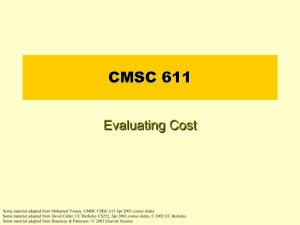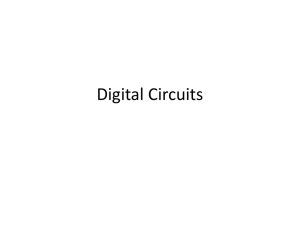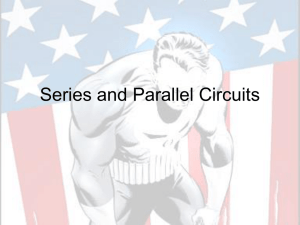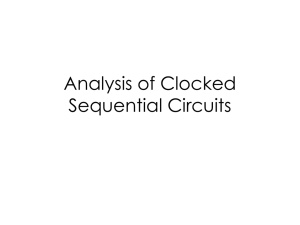Introduction PowerPoint
advertisement
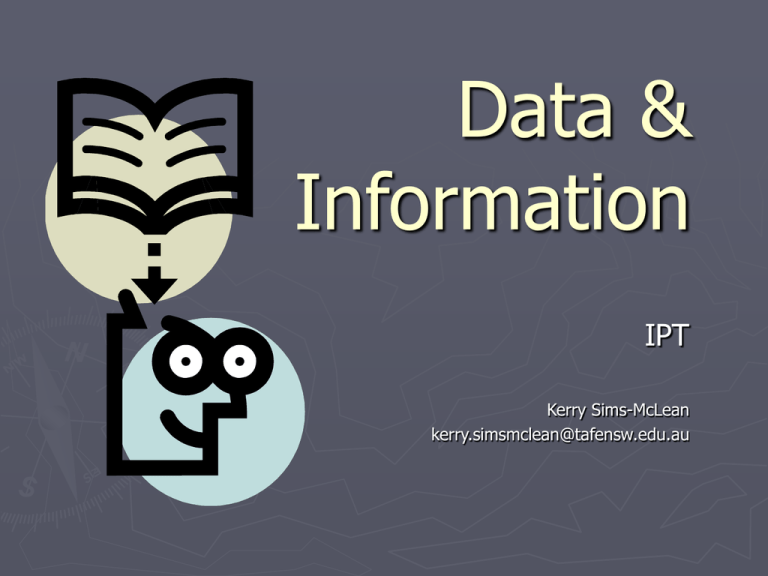
Data & Information IPT Kerry Sims-McLean kerry.simsmclean@tafensw.edu.au Outline ► Hardware ► Software ► Nature of data & information ► Digital representation of data ► Manufacturing of integrated circuits ► Information processes Hardware These are the physical components of the Computer System. That is, the things you can pick up and touch such as systems box, mouse, interface cards, printers and monitors. Peripheral device - any input/output (I/O) device which is connected to the central processing unit of the computer. ► ► Input devices Output devices Good Websites for Hardware ► Supercomputers http://www.sgi.com/products/supercomputers.html ► The PC Guide http://www.pcguide.com/topic.html ► PC Webopedia http://www.pcwebopaedia.com/ ► Computer Components http://home.rmci.net/rdavid/is310/week2&3/index.htm ► Scanning Tips http://www.scantips.com/ Memory 1 byte = 8 bits 1 kilobyte (Kb) = 1024 bytes 1 megabyte (Mb) = 1024 Kb 1 Gigabyte (Gb) = 1024 Mb Software These are the instructions used to run the computer. There are two main types of software, one type deals with the management of the processes of running the computer and is called SYSTEMS software. The other type is used when a specific task is done on the computer and this is called APPLICATIONS software. Nature of data & information ► The CPU is a microprocessor where all of the major processing of data into information takes place. It is placed on the motherboard inside the systems box. ► Processes are the steps that the computer-based system follows to turn data into information. ► Most processing is completed in the CPU ready for output to the user. The control unit and the ALU work together to execute program instructions, which are stored in primary memory. Types of Data ► Images Data in the form of pictures, drawings, paintings or photographs. ► Audio Data in the form of sounds. ► Video Data in the form of pictures and sounds combined and displayed over time. ► Text ► Numbers Data in the form of letters, numbers and other characters whose meaning and format is not specified. Data in the form of predefined characters (usually numerals) whose meaning and format is not specified. The 5 logical elements of a processing system Storage Input Process Control Output INPUT where data is entered into the system OUTPUT where information is used from the system PROCESS where data is changed into information STORAGE where information is placed for later processing CONTROL where the movement of data within the system is regulated Digital representation of data ► Data is the numbers, character, or symbols which are entered into, stored and processed by a computer system. ► Computer systems can only process digital data, hence all data is represented by a series of on or off states. ► So the binary number system, which is made up of only two digits "0" & "1", is used. "1" is used to represent the on state. "0" is used to represent the off state. Reasons for using binary numbers in a computer based system ► A computer-based system is made up of electronic circuits. These circuits carry two states, a low and a high charge. Manipulating the charges so that they can do something of use is what the computer does. ► The binary number system is well suited for this manipulation because it is a TWO STATE number system. It can be used as a model of the computer's circuit's with a '0' representing a low charge and a '1' as a high charge. ► By manipulating the circuits of a computer-based system to behave like a binary number system, the computer is able to perform calculations, the bases of all its operation. ► Other number systems can be used, but the difficulty of creating more than two states make them impractical. ► Each state is called a bit (from binary digit). A bit is the smallest possible unit. ► A character is made up of 8 bits. This is called a byte. ► Sets of bits of lengths 16-bit, 32-bit and 64-bit are known as words. A word is the number of bits the CPU can process at one time. (Generally, the larger the number of bits the faster the machine). Converting binary numbers to decimal Now we will look at how to convert the binary number shown above to decimal … Example Example: Convert 1011 to a decimal Step 1: Step 2: Decimal Value = 8+2+1 = 11 Answer: 1011 = 11 the following decimal numbers as 3 bit binary numbers 0 1 2 3 4 5 6 7 ANSWERS ► Write 000 001 010 011 100 101 110 111 Question Example: Convert 143 to a binary number Step 1: 1 0 0 0 1 1 1 Step 2- Check: 128 + 8 + 4 + 2 + 1 = 143 Answer: 143 = 10001111 1 Integrated Circuits Integrated circuits can be found on computer circuit boards such as motherboards. Each chip contains millions of logic gates. Very Large Scale Integration (VLSI) is the name given to the manufacture of chips that contain large numbers of logic gates. ICs are also called silicon chips because they are constructed on thin slices of silicon called silicon wafers. Manufacturing of integrated circuits – main stages ► Design translation ► Lithography - photo-masking - preparing the chip surface - exposure - etching ► Testing ► Packaging The Silicon Wafer SILICON is made from rocks and sand. It is melted down into a form 99.9% pure silicon The molten Silicon is “grown” (much like a candle is made) into cylindrical ingots. A diamond saw slices the ingot into circular Wafers 4 to 6 inches in diameter and 4/1000 of an inch thick. ► The resulting wafers are sterilised and polished to a mirror like finish. These wafers must be free from deformities and blemishes. ► The wafer is the starting point of creating chips. Chip Creation ► Computer Aided Design (CAD) programs are used to draw up each layer of the circuit and to test if it will work before actual manufacture begins - adv. ► CAD programs produce a circuit design called a photomask for each layer of the IC. Each photomask has many copies of the same circuit on it. The circuit is usually shown as transparent tracks on the opaque sheet or mask. ► Large silicon crystals are grown in a lab. Each crystal is very thinly sliced into wafers so it can be used as the basis of the circuit. ► Semi-conductor material is layered onto this wafer. ► The Semi-conductor material is then coated with a light-sensitive material called photoresist. ► The wafer and layers are then covered by the photomask and exposed to ultraviolet (UV) light. ► The photoresist is designed so that it is hardened by exposure to UV light. The circuit hardens, but the non-circuit parts are covered by the mask and so are protected from the light and remain soft. ► These soft unexposed parts and their underlying semi-conductor material are then eaten away in an acid bath in a process called etching, leaving the raised circuit on the wafer. ► The wafer is then cut up into individual chip-sized pieces and the individual ICs are tested. ► The IC is then packaged - the layers of silicon are put together and each chip is bonded to its legs and encapsulated in plastic. After packaging the chip is tested again before being distributed. ► During Manufacture ► Vibrations or contaminants such as dust, skin flakes or hair can ruin the chip by misaligning paths or damaging components. Hence,chips must be made in dust-free environments. Precautions include: ► “Clean rooms” are used where incoming air is passed through very fine air filters and the air is kept at a higher pressure than outside so that when the door is opened, air is forced out and contaminants don’t enter. ► Air conditioning to ensure a constant temperature Workers wear lint-free suits, gloves, shoes, masks and hoods, commonly referred to as bunny suits. Rooms are located away from sources of vibration such as roads, flight paths, elevator shafts and generators. Sticky mats at the door to remove any dust from shoes


